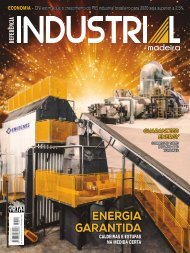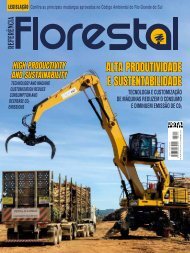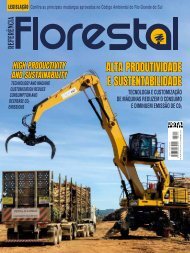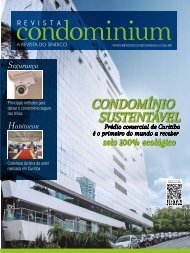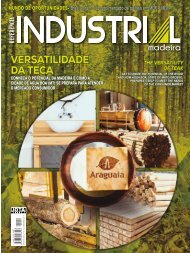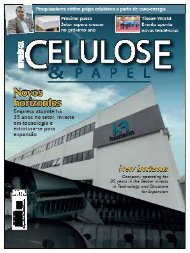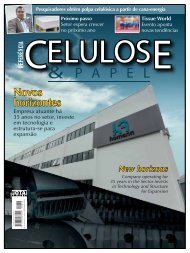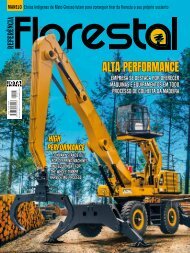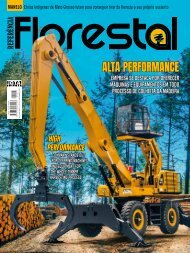Dezembro/2017 - Referência Florestal 192
Visitantes - Grupo Jota Comunicação
Visitantes - Grupo Jota Comunicação
You also want an ePaper? Increase the reach of your titles
YUMPU automatically turns print PDFs into web optimized ePapers that Google loves.
Quais são os principais quesitos a serem avaliados antes de<br />
iniciar qualquer empreendimento florestal?<br />
Número um é definir o objetivo da produção. Será para consumo<br />
próprio (energia, construções rurais, outros usos), para<br />
atender ao mercado, ou ambos? Conhecer o mercado que<br />
pretende atuar - qual é o produto, quais as características do<br />
produto são exigidas pelo mercado, quantos são os consumidores<br />
e produtores, qual o tamanho e a capacidade que os<br />
mesmos têm de influenciar o mercado, qual o preço médio<br />
pago pelos principais clientes e, se possível, como este tem<br />
oscilado nos últimos anos. Verificar quais são as condições de<br />
clima e solo da região (a análise conjunta destes três fatores<br />
orientará a escolha da espécie florestal com bom potencial<br />
produtivo e retorne um produto que atende ao mercado almejado).<br />
Analisar qual sistema de manejo florestal lhe permitirá<br />
obter o produto almejado (espaçamento, adubação, desbastes,<br />
desramas, rebrota ou outros tratos silviculturais) e os seus custos<br />
esperados. Definir a escala de produção e a sazonalidade<br />
que pretende ofertar os seus produtos. Conhecer os custos<br />
de colheita e transporte previstos e adequados à sua escala.<br />
Analisar o retorno econômico esperado para então tomar a<br />
decisão sobre a realização do investimento.<br />
Quais são os maiores erros que observa nesta área?<br />
O plantio de florestas sem conhecer o mercado ou a estrutura<br />
dos custos envolvidos na cadeia produtiva, baseando-se apenas<br />
em informações genéricas. O setor florestal é heterogêneo,<br />
possibilitando diversas opções de produção e comercialização<br />
da madeira e outros produtos advindos das florestas. O potencial<br />
de retorno econômico muda ao se alterar o mercado,<br />
a espécie, a localização e até a escala de produção. Esta última<br />
exerce influência principalmente na execução das operações<br />
de colheita e transporte, que representam uma proporção<br />
significativa do custo total da madeira entregue no cliente,<br />
principalmente para produtos de menor valor agregado. Um<br />
artigo da Consufor publicado recentemente na REFERÊNCIA<br />
FLORESTAL conclui que o valor total da colheita e transporte<br />
florestal de pinus e eucalipto superou em 17% o valor da madeira<br />
em pé no país. O custo de colheita e transporte chegou<br />
a 60% do preço da madeira no cliente para toras finas, e 24%<br />
em toras grossas para laminação (maior valor agregado).<br />
Com a opção de diversas espécies novas, o que precisa ser<br />
avaliado antes de escolher qual será plantada?<br />
Antes de se escolher a espécie, é necessário observar os itens<br />
listados na primeira pergunta. Espécies novas apresentam um<br />
desafio adicional quando comparadas às espécies consolidadas<br />
(pinus e eucalipto) em relação à carência de informações e<br />
materiais genéticos adaptados e de elevada produtividade.<br />
Entretanto, normalmente se propõem à produção de madeiras<br />
com maior valor agregado, possibilitando maiores ganhos,<br />
mas demandando maior profissionalização do produtor e um<br />
uso mais intenso das ciências florestais no manejo da floresta.<br />
What are the main requirements to be evaluated before<br />
starting any forest project?<br />
Number one is to define the production objective. Will it be<br />
for in-house consumption (energy, rural constructions, other<br />
uses), or to cater to a specific market, or both? Knowing the<br />
market in which you intend to sell - what is the product, what<br />
are the characteristics required of the product by the market,<br />
who and how many consumers and producers are there,<br />
what is their size and ability they have to influence the market,<br />
what is the average price paid by main customers and, if<br />
possible, how this has fluctuated over recent years. Check out<br />
the climate and soil conditions of the region (a joint analysis<br />
of these three factors will guide in the choice of forest species<br />
with a good productive potential and return with a product<br />
that meets the needs of the target market). Analyze which<br />
forest management system will allow you to obtain the desired<br />
product (spacing, fertilizing, pruning, regrowth or other<br />
forestry treatments) and their expected costs. Define the<br />
scale of production and market seasonality of the products<br />
you intend to offer. Know the harvesting and transport costs,<br />
forecast and suitable to your production scale. Analyze the<br />
expected economic return in order to then make a decision<br />
about the realization of the investment.<br />
What are the biggest mistakes that you have observed in<br />
this area?<br />
Planting forests without knowing the market or the cost<br />
structure involved in the productive chain, using only what<br />
is based on general information. The Forest Sector is heterogeneous,<br />
enabling various options for timber production<br />
and marketing and for other products from the forest. The<br />
potential economic return changes with altering the market,<br />
species, location and even scale of production. The latter influences<br />
mainly the implementation of the harvesting system<br />
and transportation operations, which represent a significant<br />
proportion of the total cost of timber delivered to the customer,<br />
especially for lower-value-added products. An article<br />
published recently in REFERÊNCIA <strong>Florestal</strong> about Consufor<br />
concludes that in Brazil, the total value of forest harvesting<br />
and transport of pine and eucalyptus in the Country surpassed<br />
17% of the value of the standing timber. The cost of<br />
harvesting and transport reached 60% of the timber price for<br />
thin log customers, and 24% for thick logs used for veneer<br />
(value added).<br />
With the option of various new species, what needs to be<br />
assessed before choosing which will be planted?<br />
Before choosing the species, it is necessary to note the items<br />
listed in the first question. New species present an additional<br />
challenge when compared to the consolidated species (pine<br />
and eucalyptus) in relation to the lack of information, the<br />
genetic materials used and high productivity. However, one<br />
normally proposes the production of timber with a higher<br />
<strong>Dezembro</strong> de <strong>2017</strong> REVISTA REFERÊNCIA FLORESTAL<br />
29



